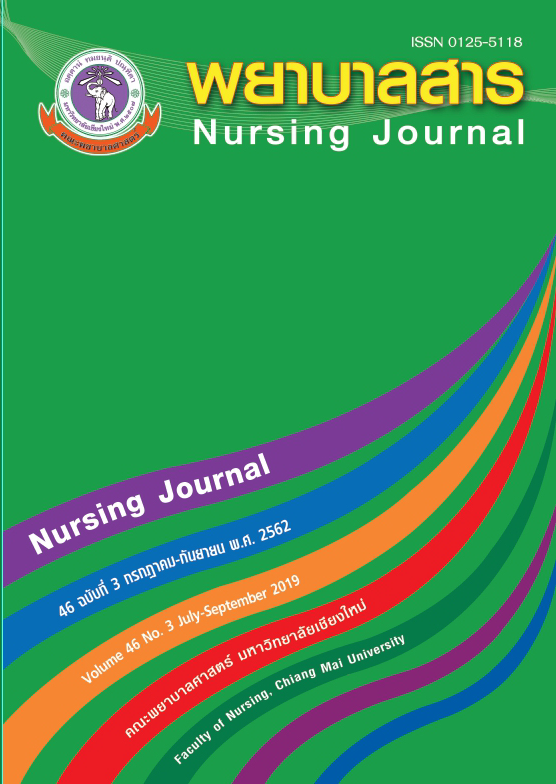Development of “Kratib Kao” for Controlling Food Consumption for Persons with Diabetes
Keywords:
Kratib Kao, Food consumption, Sticky rice, Diabetes MellitusAbstract
Persons with diabetes must control rice consumption in order to control blood sugar. Equipment to monitor rice consumption is needed for persons with diabetes to help control rice consumption. This research aimed to develop and examine the possibility of using a specialized Kratib Kao to control rice consumption in persons with type 2 diabetes. The participants consisted of 20 persons with type 2 diabetes living in Chiang Mai and Phayao provinces. The research was divided into 2 phases. The first phase was to explore problems and needs of persons with diabetes to control blood sugar by using a Kratib Kao. Two focus group discussions with 12 participants each were conducted and a Kratib Kao was designed according to the suggestions. The second phase aimed to study the feasibility of using a Kratib Kao to control rice consumption among 8 participants. These participants met the inclusion criteria of having HbA1c> 7%, or fasting blood sugar> 130 mg/dl and consumed sticky rice with at least one meal a day. All subjects were asked to use a specialized Kratib Kao for one month after being informed about Kratib Kao utilization and ways to control rice consumption. The instruments used to gather information consisted of 1) a demographic data recording form, 2) guided questions for the focus group, 3) satisfaction questionnaire, 4) 7-day food record, and 5) Nutri-fact program to compute daily energy. Data were analyzed using descriptive statistics.
Based on participant feedback the Kratib Kao was created and included 2 parts: 1) Kratib Kao for rice 2) a Kratib-base which was composed of a switch, save button, meal switch, rice switch, monitor, battery charger pole and cable, and memory card. After 1 month, caloric intake from carbohydrates decreased from 783.69 kilocalories or 49.28 % to 568.42 kilocalories or 35.73% of total calorie intake per day, which is below the national recommendation (<50%). Calorie intake from sticky rice and plain rice also decreased from 255.59 to 203.61 kilocalories and 363 to 131.84 kilocalories for each meal. Moreover, the participants reduced rice consumption at dinner, resulting in reduced caloric intake from 294.02 to 198.48 kilocalories. All participants were satisfied with the Kratib Kao, since it immediately fed the data back to them and allowed them to control the amount of rice consumed at each meal.
The results of this study indicated that a Kratib Kao can help diabetic patients to control rice consumption. Thus, it should be further tested for effectiveness in controlling blood sugar among persons with diabetes.
References
Ahn, H.J., Han, K.A., Kwon, H.R., & Min, K-W. (2010). The small rice bowl-based mean plan was effective at reducing dietary energy intake, body weight, and blood glucose levels in Korean women with type 2 diabetes mellitus. Korean Diabetes, 34, 340-349. doi: 10.4093/kdj.2010.34.6.340.
Ahn, H.J., Han, K.A., Kwon, H.R., . . . and Min, K-W. (2010). Small rice bowl-based meal plan versus food exchange-based meal plan for weight, glucose and lipid control in obese type 2 diabetic patients. Korean Diabetes, 34(2), 86-94. doi: 10.4093/kdj.2010.34.2.86
American Diabetes Association.(2004). Nutrition principles and recommendations in diabetes. Diabetes Care, 27(supplement 1), S36-S46.
Boonvisut, S. (2011). Nutritive Values of Thai foods. Bangkok: War Veterans Organization of Thailand Printing.
Chonngam S. (2013). Research Report: Food Consumption Behavior of Diabetic Patients with HbA1C above 7% in Noen Maprang district, Phitsanulok Province. Phitsanulok: Provincial Public Health Office.
Chuayen J., Rerkasem K., Wungrath J., . . . , and Jungsathit K. (2015, October). Development of NutriFact Program for the Nutritive Values of Thai and Local Northern Thai Recipes. Poster session presented at the 9th TCN Conference; Bangkok, Thailand.(In Thai)
Diabetes Asssociation of Thailand Under The Patronage of Her Royal Highness Princess Maha Chakri Sirindhon. (2014). Clinical Practice Guideline for Diabetes 2014. Bangkok: Srimuang Printing.
Institute of Medical Research and Technology Assessment. (2013). Situation of Diabetes, Hypertension and complication in Thai 2013. Department of Medical Service. Ministry of Public Health.
International Diabetes Federation. (2015). Online version of IDF Diabetes Atlas (7th Ed.). Retrieved from www.diabetesatlas.org
Intharabut, M. and Muktabhant, B. (2007). Perception and Practices of Dietary Control in Type 2 Diabetic Patients. Srinagarind Medical Journal. 22(3), 283-290. (In Thai)
Kingkaew, P. (2007). Comparative Study on Food Consumption Behavior Between Controlled and Uncontrolled Plasma Glucose Level of Type 2 Diabetic Patients, Khuangnai Hospital, Ubonratchathani Province. MPH Dissertation. Graduate School, Khon Kaen University. (In Thai)
Suwankruhasn, N., Pothiban, L., Panuthai, S., and Boonchuang, B. (2013). Effects of a Self-management Support Program for Thai People Diagnosed with Metabolic Syndrome. Pacific Rim International Journal of Nursing Research ;17(4) 371-383. (In Thai)
National Health Examination Survey Office: NHESO. (1971). The report of the fourth Thai national Health examination Survey. Nonthaburi: The Graphico Systems.
Pradidthaprecha, A. and Muktabhunt, B. (2011). Food Consumption Pattern of New Diagnose of Type 2 Diabetic and Non-Diabetic People in Naklang District, Nongbualumphu Province. Journal of The Office of Disease Prevention and Control 7 Khon Kaen, 18(2), 76-86. (In Thai)
Sangpeach, J. (2006). Food Consumption Behavior and Self-care of Type 2 Diabetic Patients in One Stop Service Clinic, Khon Kaen Hospital. MPH. Dissertation. Graduate School, Khon Kaen University. (In Thai)
Downloads
Published
How to Cite
Issue
Section
License
บทความที่ได้รับการตีพิมพ์เป็นลิขสิทธิ์ของวารสารพยาบาลสาร
ข้อความที่ปรากฏในบทความแต่ละเรื่องในวารสารวิชาการเล่มนี้เป็นความคิดเห็นส่วนตัวของผู้เขียนแต่ละท่านไม่เกี่ยวข้องกับมหาวิทยาลัยเชียงใหม่ และคณาจารย์ท่านอื่นๆในมหาวิทยาลัยฯ แต่อย่างใด ความรับผิดชอบองค์ประกอบทั้งหมดของบทความแต่ละเรื่องเป็นของผู้เขียนแต่ละท่าน หากมีความผิดพลาดใด ๆ ผู้เขียนแต่ละท่านจะรับผิดชอบบทความของตนเองแต่ผู้เดียว






